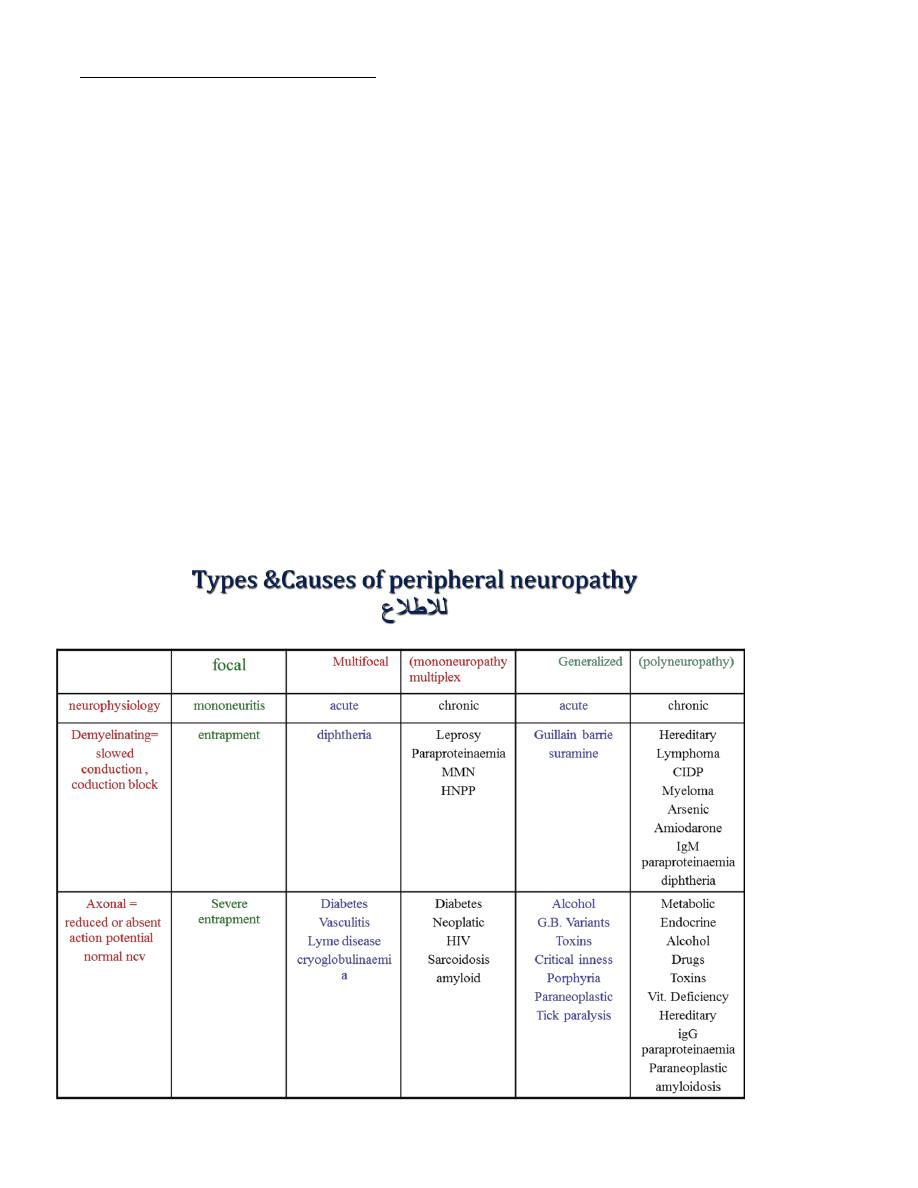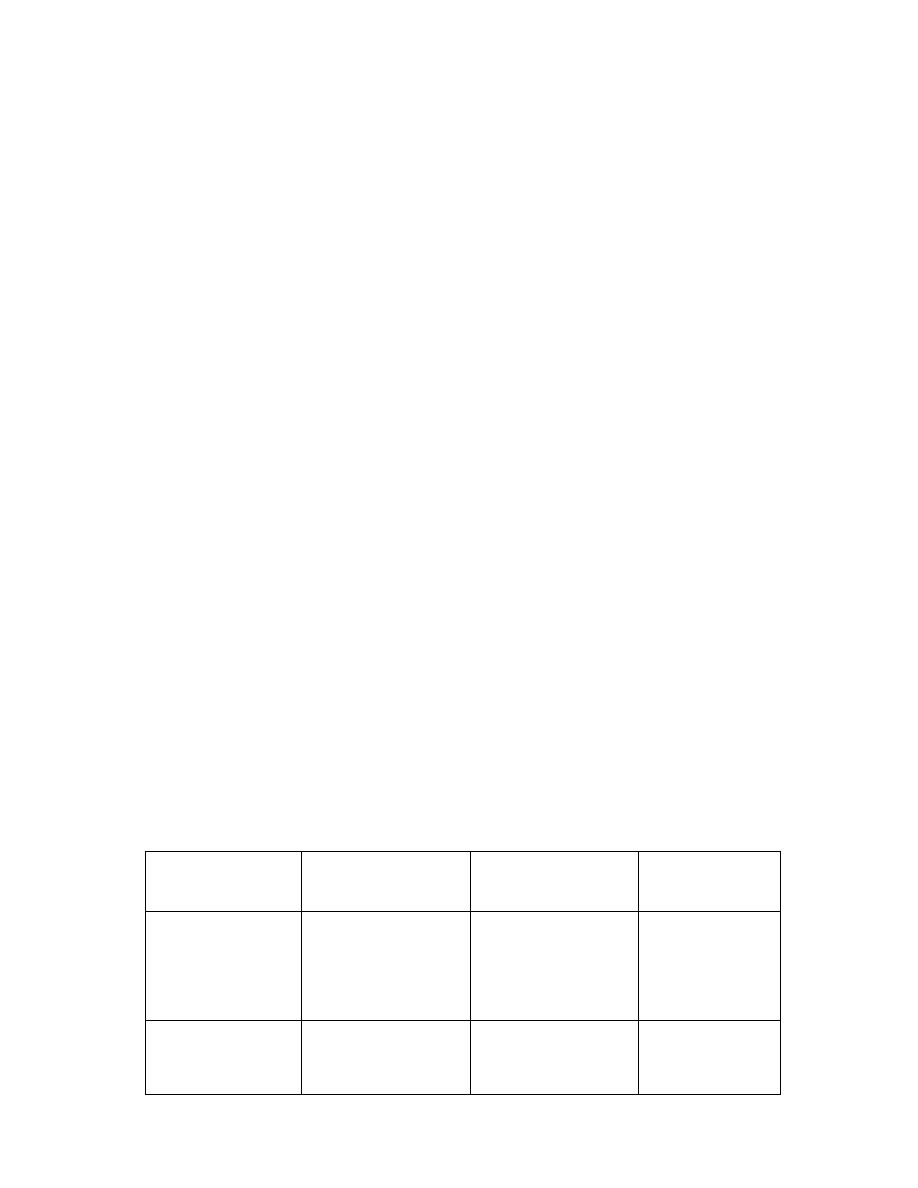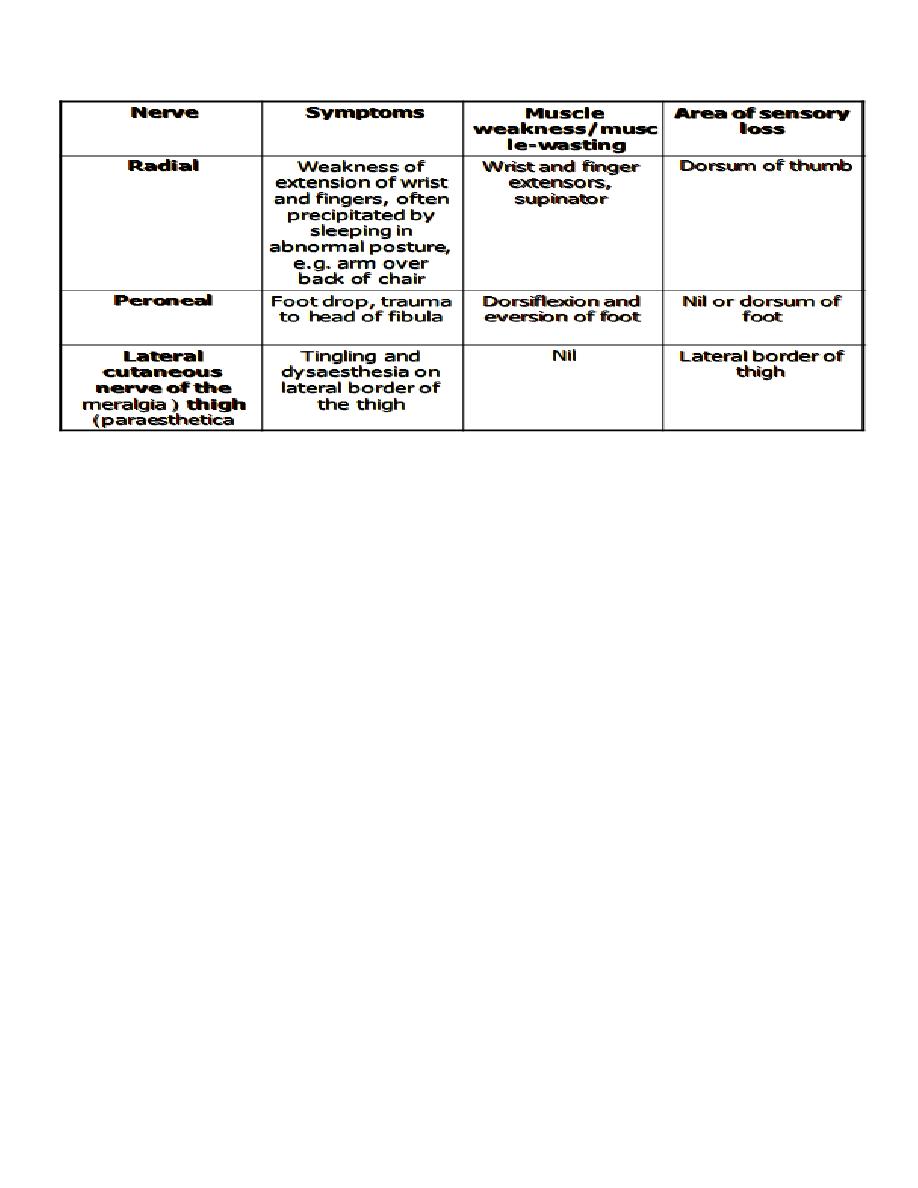
DISEASES OF PERIPHERAL NERVES
Numerous inherited and acquired pathological processes may affect the nerve roots
(radiculopathy), the nerve plexuses (plexopathy) and/or the individual nerves (neuropathy).
Cranial nerves 3-12 share the same tissue characteristics as peripheral nerves elsewhere and
are subject to the same range of diseases. Nerve fibres of different types (motor, sensory or
autonomic) and of different sizes may be variably involved. Disorders may be primarily
directed at the axon, the myelin sheath (Schwann cells) or the vasa nervorum
PATTERN OF INVOLVMENT
Mononeuropathy Simplex=Single Nerve
Mononeuropathy Multiplex=Several Nerves Randomly &Noncontiguously
Polyneuropathy( Peripheral Neuropathy)=Dysfunction of Numerous Peripheral Nerves at the
Same Time leading to predominantly distal & symmetrical deficit usually affecting lower more
than upper limbs

Diseases of Peripheral Nerves
SYMPTOMS &SIGNS
1.Sensory Disturbances
A.Numbness, Hyperpathia, Impaired Sensation & SPONTANEOUS PAIN esp. in SMALL FIBER
involvement ;D. M. , Porphyria, AIDS, Alcoholic, Entrapment …..
B. Dissociated Sensory Loss Small Fib. Pain &Temp.
Large Fib. Touch, Vib. & Position
2. MOTOR DEFICITS
Weakness , Wasting , Fasciculation
Diminished or Absent Reflexes
i.e. LMNL
3.AUTONOMIC DISTURBANCES
Post. Hypotension, Coldness, Imp. Sweating, Impotence….esp. GBS, Diabetes, Renal Failure,
Porphyria….
4. ENLARGED NERVES
Leprosy, Amyloidosis, HSMN, Refsum Dis., Acromegaly..
Causes of P. N .
1. Inflammatory: GBS , CIPD
2. Metabolic &Nutritional :D.M. ,Uremia, Liver Failure, Hypothyroidism, Acromegaly, B12
Deficiency….
3.Infectious &Granulomateous:AIDS, Leprosy, Diphtheria, Sarcoidosis…
4.Vasculitis: PAN, SLE, Rh.Arthritis…
5.Neoplastic &Paraneoplastic
6. Drugs &Toxins:Alcohol, INH, Vinicristine, Phenytoin, Heavy Metals….
7.Hereditory:HSMN, HSN, Refsum Disease,Porphyria..
8. IDIOPATHIC

Drugs causing peripheral neuropathy
DIFFERENTIAL DIAGNOSIS
Diseases of muscles &n.m. junction
normal sensation& tendon reflexes
Diseases of spinal cord
pyramidal signs &sensory level below the lesion
Radiculopathies
dermatomal &myotomal distribution
INVESTIGATIONS
CONFIRM DIAGNOSIS
EMG = DENERVATION
ENG &NCV = Demyelination or Axonal Degeneration
REVEAL UNDERLYING CAUSE
TREATMENT
UNDERLYING CAUSE
NURSING CARE ? ULCERS &CONTRACTURES
RESPIRATORY MONITORING &MANAGEMENT
CARE OF SKIN &NAILS
A
A
m
m
i
i
o
o
d
d
a
a
r
r
o
o
n
n
e
e
,
,
s
s
t
t
a
a
t
t
i
i
n
n
s
s
,
,
h
h
y
y
d
d
r
r
a
a
l
l
a
a
z
z
i
i
n
n
e
e
C
C
a
a
r
r
d
d
i
i
o
o
v
v
a
a
s
s
c
c
u
u
l
l
a
a
r
r
a
a
g
g
e
e
n
n
t
t
s
s
C
C
i
i
s
s
p
p
l
l
a
a
t
t
i
i
n
n
e
e
,
,
t
t
h
h
a
a
l
l
i
i
d
d
o
o
m
m
i
i
d
d
e
e
,
,
v
v
i
i
n
n
c
c
r
r
i
i
s
s
t
t
i
i
n
n
e
e
C
C
h
h
e
e
m
m
o
o
t
t
h
h
e
e
r
r
a
a
p
p
u
u
t
t
i
i
c
c
a
a
g
g
e
e
n
n
t
t
s
s
C
C
h
h
l
l
o
o
r
r
a
a
m
m
p
p
h
h
e
e
n
n
i
i
c
c
o
o
l
l
,
,
I
I
N
N
H
H
,
,
E
E
T
T
B
B
,
,
n
n
i
i
t
t
r
r
o
o
f
f
u
u
r
r
a
a
n
n
t
t
o
o
i
i
n
n
,
,
m
m
e
e
t
t
r
r
o
o
n
n
i
i
d
d
a
a
z
z
o
o
l
l
e
e
A
A
n
n
t
t
i
i
-
-
i
i
n
n
f
f
e
e
c
c
t
t
i
i
v
v
e
e
a
a
g
g
e
e
n
n
t
t
s
s
G
G
o
o
l
l
d
d
,
,
d
d
i
i
s
s
u
u
l
l
f
f
i
i
r
r
a
a
m
m
,
,
p
p
y
y
r
r
i
i
d
d
o
o
x
x
i
i
n
n
e
e
,
,
t
t
a
a
c
c
r
r
o
o
l
l
i
i
m
m
u
u
s
s
,
,
c
c
o
o
l
l
c
c
h
h
i
i
c
c
i
i
n
n
e
e
,
,
p
p
h
h
e
e
n
n
y
y
t
t
o
o
i
i
n
n
O
O
t
t
h
h
e
e
r
r
s
s

RELIEF OF PAIN ----Lancinating Pain--PHENYTOIN
CARBAMAZEPINE
MEXILETINE
Constant Pain----AMITRIPTYLINE
GABAPENTINE,PREGABALIN
GUILLIAN BARIE SYNDROME ACUTE ASCENDING POLYRADICLONEUROPATHY
This syndrome of acute paralysis develop in 70 % of patients 1-4 weeks after respiratory
infection or diarrhoea (particularly Campylobacter).
In Europe and North America, acute inflammatory neuropathy is most commonly
demyelinating ( AIDP ).
Axonal variants are more common in China and Japan .
Clinical features
Distal paraesthesia and limb pains precede a rapidly ascending muscle weakness from lower to
upper limbs , more marked proximally than distally.
Facial and bulbar weakness commonly develops , and respiratory weakness requiring
ventilatory support occurs in 20 % of cases .
In most patients weakness progresses for 1-3 weeks but rapid deterioration to respiratory
failure can develop within hours
On examination there is diffuse weakness with widespread loss of reflexes.
Overall, 80% of patients recover completely within 3-6 months, 4% die, and the remainder
suffer residual neurological disability which can be severe. Adverse prognostic features include
older age, rapid deterioration to ventilation and evidence of axonal loss on EMG.
Investigations
The CSF protein is abnormal at some stage of the illness, but may be normal in the first 10
days. There is usually no rise in CSF cells ( lymphocytosis of > 50/ml suggests an alternative
diagnosis ).
Electrophysiological studies are often normal in the early stages but show typical changes after
a week or so , with conduction block and multifocal motor slowing , sometimes most evident
proximally as delayed F-waves.

Management
During the phase of
deterioration , regular monitoring of respiratory function ( vital capacity and arterial blood
gases) is required, as respiratory failure may develop with little warning and require
ventilatory support.
Ventilation may be needed if the vital capacity falls below 1L , but ventilation is more often
required because of bulbar weakness leading to aspiration.
General management to protect the airway and prevent pressure sores and venous
thrombosis is essential .
Corticosteroids have been shown to be ineffective .
Plasma exchange and intravenous immunoglobulin therapy shorten the duration of the illness
,reduce severity and improve prognosis provided treatment is started within 14 days of the
onset of symptoms .
DIABETIC NEUROPATHY
AMYOTROPHY = PAIN &WEAKNESS WITH ATROPHY PELVIC GIRDLE &THIGH MUSCLES
WITH ABSENT KNEE REFLEX &LITTLE SENSORY LOSS
MONONEUROPATHY = ACUTE PAINFUL CRANIAL NERVES
BOTH HAVE GOOD PROGNOSIS
Entrapment neuropathy
Focal compression or entrapment is the usual cause of mononeuropathy . However , some
patients present with what initially appears to be a single nerve lesion and then go on to
develop multiple nerve lesions.This is termed mononeuritis multiplex .
Symptoms and signs
A
A
r
r
e
e
a
a
o
o
f
f
s
s
e
e
n
n
s
s
o
o
r
r
y
y
l
l
o
o
s
s
s
s
M
M
u
u
s
s
c
c
l
l
e
e
w
w
e
e
a
a
k
k
n
n
e
e
s
s
s
s
/
/
m
m
u
u
s
s
c
c
l
l
e
e
-
-
w
w
a
a
s
s
t
t
i
i
n
n
g
g
S
S
y
y
m
m
p
p
t
t
o
o
m
m
s
s
N
N
e
e
r
r
v
v
e
e
L
L
a
a
t
t
e
e
r
r
a
a
l
l
p
p
a
a
l
l
m
m
a
a
n
n
d
d
t
t
h
h
u
u
m
m
b
b
,
,
i
i
n
n
d
d
e
e
x
x
,
,
m
m
i
i
d
d
d
d
l
l
e
e
a
a
n
n
d
d
m
m
e
e
d
d
i
i
a
a
l
l
h
h
a
a
l
l
f
f
4
4
t
t
h
h
f
f
i
i
n
n
g
g
e
e
r
r
A
A
b
b
d
d
u
u
c
c
t
t
o
o
r
r
p
p
o
o
l
l
l
l
i
i
c
c
i
i
s
s
b
b
r
r
e
e
v
v
i
i
s
s
P
P
a
a
i
i
n
n
a
a
n
n
d
d
p
p
a
a
r
r
a
a
e
e
s
s
t
t
h
h
e
e
s
s
i
i
a
a
o
o
n
n
p
p
a
a
l
l
m
m
a
a
r
r
a
a
s
s
p
p
e
e
c
c
t
t
o
o
f
f
h
h
a
a
n
n
d
d
s
s
a
a
n
n
d
d
f
f
i
i
n
n
g
g
e
e
r
r
s
s
,
,
w
w
a
a
k
k
i
i
n
n
g
g
t
t
h
h
e
e
p
p
a
a
t
t
i
i
e
e
n
n
t
t
f
f
r
r
o
o
m
m
s
s
l
l
e
e
e
e
p
p
.
.
P
P
a
a
i
i
n
n
m
m
a
a
y
y
e
e
x
x
t
t
e
e
n
n
d
d
t
t
o
o
a
a
r
r
m
m
a
a
n
n
d
d
s
s
h
h
o
o
u
u
l
l
d
d
e
e
r
r
M
M
e
e
d
d
i
i
a
a
n
n
(
(
a
a
t
t
w
w
r
r
i
i
s
s
t
t
)
)
(
(
c
c
a
a
r
r
p
p
a
a
l
l
t
t
u
u
n
n
n
n
e
e
l
l
s
s
y
y
n
n
d
d
r
r
o
o
m
m
e
e
)
)
M
M
e
e
d
d
i
i
a
a
l
l
p
p
a
a
l
l
m
m
a
a
n
n
d
d
l
l
i
i
t
t
t
t
l
l
e
e
f
f
i
i
n
n
g
g
e
e
r
r
,
,
a
a
n
n
d
d
m
m
e
e
d
d
i
i
a
a
l
l
h
h
a
a
l
l
f
f
4
4
t
t
h
h
f
f
i
i
n
n
g
g
e
e
r
r
A
A
l
l
l
l
s
s
m
m
a
a
l
l
l
l
h
h
a
a
n
n
d
d
m
m
u
u
s
s
c
c
l
l
e
e
s
s
,
,
e
e
x
x
c
c
l
l
u
u
d
d
i
i
n
n
g
g
a
a
b
b
d
d
u
u
c
c
t
t
o
o
r
r
p
p
o
o
l
l
l
l
i
i
c
c
i
i
s
s
b
b
r
r
e
e
v
v
i
i
s
s
P
P
a
a
r
r
a
a
e
e
s
s
t
t
h
h
e
e
s
s
i
i
a
a
o
o
n
n
m
m
e
e
d
d
i
i
a
a
l
l
b
b
o
o
r
r
d
d
e
e
r
r
o
o
f
f
h
h
a
a
n
n
d
d
,
,
w
w
a
a
s
s
t
t
i
i
n
n
g
g
a
a
n
n
d
d
w
w
e
e
a
a
k
k
n
n
e
e
s
s
s
s
o
o
f
f
h
h
a
a
n
n
d
d
m
m
u
u
s
s
c
c
l
l
e
e
s
s
U
U
l
l
n
n
a
a
r
r
(
(
a
a
t
t
e
e
l
l
b
b
o
o
w
w
)
)

In an entrapment neuropathy, pressure initially damages the myelin sheath, and
neurophysiology will show slowing of conduction over the relevant site. Sustained or severe
pressure damages the integrity of the axons, demonstrable as loss of the sensory action
potential distal to the site of compression.
Certain conditions increase the propensity to develop entrapment neuropathies. These include
acromegaly, hypothyroidism, pregnancy, any pre-existing mild generalised axonal neuropathy
(e.g. diabetes), and oseophytes.
Entrapment neuropathy
CTS
MEDIAN N. COMPRESSION AT THE WRIST
IDIOPATHIC, PREGNANCY, TRAUMA, ARTHRITIS, MYXOEDEMA, ACROMEGALY,
TENOSYNOVITIS……
PAIN, NUMBNESS IN MEDIAN N. DISTIBUTION ?SHOULDER
> AT NIGHT
WEAKNESS & ATROPHY OF THENAR MUSCLES
TINEL SIGN , PHALEN MANEUVER
Rx LOCAL STEROIDS, WRIST SPLINT, SURGERY

Facial nerve palsy
Idiopathic facial nerve palsy or Bells palsy is a common condition affecting all ages and both
sexes .The lesion is within the facial canal and may be due to reactivation of latent herpes
simplex virus 1 infection .Symptoms usually develop subacutely over a few hours , with pain
around the ear preceding the unilateral facial weakness. Patients often describe the face as
numb but there is no objective sensory loss (except possibly to taste).
Hyperacusis can occur if the nerve to stapedius is involved , and there may be diminished
salivation and tear secretion . Examination reveals an ipsilateral lower motor neuron facial
nerve palsy . Vesicles in the ear or on the palate indicate that the facial palsyis due to herpes
zoster rather than Bells palsy .
Prednisolone 40-60 mg daily for a week speeds recovery if started within 72 hours.Artificial
tears and ointment prevent exposure keratitis and the eye should be taped shut overnight.
About 80% of patients recover spontaneously within 12 weeks. A slow or poor recovery is
predicted by complete paralysis, older age and reduced facial motor action potential
amplitude after the first week. Recurrences can occur but should prompt further investigation.
Aberrant re-innervation may occur during recovery, producing unwanted facial movements
(e.g. eye closure when the mouth is moved) or 'crocodile tears' (tearing during salivation).
